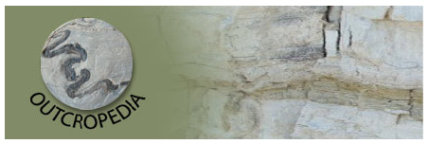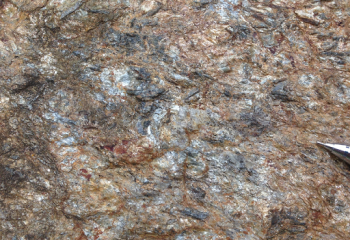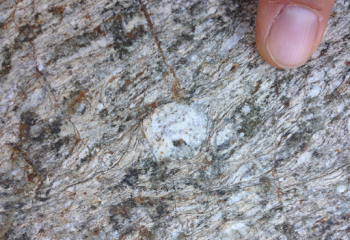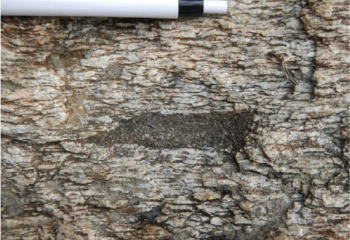Excerpt
The Variscan basement in NE Sardinia
The Variscan basement in Corsica and Sardinia is an almost complete section across the South Variscan belt showing thetransition from very low-grade up to mediumhigh- grade basement (Fig.1).The aim of the field trip is to cover a section of the basement of Northern Sardinia to see the effects of progressivedeformation and metamorphism along one of the classic geological transect in the Variscan belt in Northeastern Sardinia.
From south to north we observe clearly the effects of the D1 contractional deformation with south verging recumbent foldsand ductile/brittle shear zones affected by a D2 deformation, with strain increasing northward and tectonic transport parallel tothe belt. The rocks, which are of Paleozoic age, underwent progressive Barrovian-type metamorphism increasing northward.
Sardinia and Corsica were brought into their present position by a 30° anticlockwise rotation of the Corsica-Sardinia blockaway from Europe caused by the opening of the Western Mediterranean Ligurian-Provencal basin. The rifting phase tookplace in the Oligocene (from 30 to 24 Ma) and was followed by a short Early Miocene oceanic accretion (ages ranging from23 to 15 Ma, Ferrandini et al., 2000 and references therein).
The basement consists mainly of high-grade metamorphic rocks and was termed the “inner zone” by Carmignani et al. (1979; 1994; 2001) (Fig. 1), and it is the result of a continental collision. The different structural Variscan zones were definedin Sardinia where Variscan metamorphic complexes crop out widely and were extensively surveyed.
The Variscan belt in Sardinia developed from deformation and metamorphism of the northern margin of Gondwana and Gondwana-derived terranes during the Carboniferous, involving sedimentary and magmatic sequences ranging in age fromCambrian to Lower Carboniferous (Carmignani et al., 1994; 2001).
The itineray will show the effetc of D2 post collisional transpressive deformation and associated metamorphic evolution in the Variscan Basement of Ne Sardinia close to the Posada-Asinara Line (Carosi & Palmeri, 2002).
An exaustive description of the geology of the area can be found in Carosi et al. (2015) (free download): http://www.isprambiente.gov.it/it/pubblicazioni/periodici-tecnici/geological-field-trips/the-variscan-basement-in-sardinia
References
Carosi R., Cruciani G., Franceschelli M., Montomoli C. (2015). The Variscan Basament in Sardinia. Field guide to the excursion of the 29th Himalaya-Karakoram-Tibet Workshop, 5-8 September 2014. Società Geologica Italiana, Geological Field Trip, pp 114. http://www.isprambiente.gov.it/it/pubblicazioni/periodici-tecnici/geological-field-trips/the-variscan-basement-in-sardinia
-
1
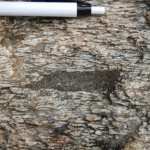
Orthogneiss
Deformed mafic microgranular enclave in the sheared Ordovician granodioritic orthogneiss.
-
2
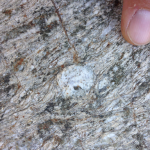
Sigma type porhyroclast
Sigma type porhyroclast in Ordovician augen gneiss, top-to-the NW sense of shear. On the road from Siniscola to Lodè, at deviation to Torpè, there are sheared granitic augen gneiss. This Gneiss are highly deformed by the D2 shearing phase showing cm-size shear bands and rotated porphyroclast
-
3
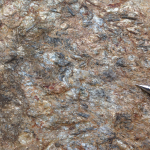
Garnet + staurolite bearing micaschist
On the road from Torpè village to Lodè (S. Anna villages) there is an outcorp of staurolite and garnet bearing micaschist: near the gate at the entrance of a small forest track, we see cm-sizestaurolite and garnet porphyroclasts on the S2 foliation of the micaschist. Garnet and staurolite grew after the D1 and from pre-to…
-
4
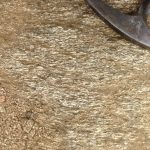
S-C-C’ fabric in orthogneiss
S-C-C’ fabric in Ordovician orthogneiss, top-to-the NE sense of shear and thin section photo (II nicols). On the road near of «Cantoniera Mt. Tundu» we start to see outcorps of granodioritic orthogneiss with a prominent C-S fabric and C’ structures pointing to a top-to-the NW sense of shear (“dextral”).
-
5
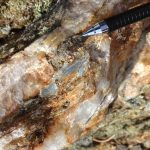
Kyanite
Kyanite bearing micaschist, Bruncu Nieddu. About 0.5 km further north along the track we reach the kyanite+biotite isograd withmm- to cm-size bluish kyanite crystals in the matrix of the mylonites and in quartz-rich veins (Fig. 1). The kyanite+biotite isograd is marked by the first appearance ofkyanite crystals. The rocks consist of porphyroblasts of staurolite, kyanite,…
-
6

Kinked augen gneiss, Lodè
Kinked augen gneiss (F3 fold). Kinks affect theS2 mylonitic foliation. Lodè.
